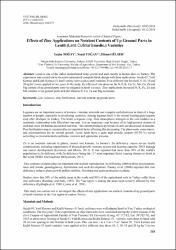Effects of Zinc Applications on Nutrient Contents of Up Ground Parts in Lentil (Lens Culinarismedic.) Varieties
Abstract
Legumes are an important source of protein, vitamins, minerals and complex carbohydrates in diets of a large number of people, especially in developing countries. Among legumes lentil is the second leading grain legume crop after chickpea in Turkey. The lentil, a legume crop, fixes atmospheric nitrogen in the root-nodules in a symbiotic relationship with Rhizobium bacteria. It is an important crop because of its high protein content of seed and straw for human and animal nutrition. The current productivity trends of lentil are decreased on decades. Poor fertilization area is considered as an important factor effecting this decreasing. The plant needs some macroand micronutrients for its normal growth. Lentil seeds have a quite high protein content (18-30 %) varied according to environmental conditions, varieties and agronomic process. Zn is an essential nutrient in plants, animal and humans. In human’s Zn deficiency causes severe health complications, including impairments of physical growth, immune system and learning capacity, DNA damage and cancer development (Levenson and Morris, 2011). It was reported that more than 30% of the world’s populations is Zn deficient, with Zn deficiency being the 11th most important factor causing disease or death in the world (WHO Micronutrient Deficiencies, 2011). Zinc contents of plants plays an important role in plant reproduction. Its deficiency inhibits floral development, male and female gametogenesis, fertilization and seed development. Pandey et al. (2006) reported that zinc deficiency reduces plant growth, pollen viability, flowering and grain production in plants. Studies show that 30% of the arable areas in the world and 50% of the agricultural soils in Turkey suffer from zinc deficiency (Kenbeay and Sade, 1987). The Van region is among the areas most severely affected by zinc deficiency (Eyüboğlu et.al. 1998, Çamaş et al. 1998). This study was carried out to investigate the effects of zinc applications on nutrient contents of up ground parts of lentil varieties in the Van region in eastern Turkey.


















